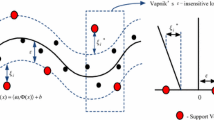Abstract
On-line tool condition monitoring is highly needed in drilling production process. Input current has been employed to monitor the drilling tool wear by many researchers. But few cases can represent the wear status and recognize the breakage simultaneously. The remaining life of tool has not been discussed sufficiently. This paper presents a strategy of on-line tool monitoring system for drilling machine using wavelet packet decomposition of spindle current signature. A moving window technique is used to extract the real drilling parts of data from sampled data sequence. The wavelet packet decomposition is used to extract features from non-stationary current signal. Critical features are selected according to their ability of discriminating the wear progress under Fisher criterion. Logistic regression combined with autoregressive moving average models are used to evaluate the failure possibility and remaining life of the drill bit. Experimental results show good performance of the proposed algorithm.
Similar content being viewed by others
References
Pechloff S (2003) Can you afford to ignore tool monitoring? Production machining. Gardner, Cincinnati
Goverkar E, Grabec I (1994) Self-organizing neural network application to drill wear classification. J Eng Ind 16(5):233–238
Liu TI, Anantharaman KS (1994) Intelighent classification and measurement of drill wear. J Eng Ind 116(5):233–238
Isermann R, Ayoubi M (1993) Model based detection of tool wear and breakage for machine tools. Proceedings of the IEEE International Conference Sys. Man Cyber. IEEE, Piscataway, vol. 3, pp 72–77
Rehorn AG, Jin J, Orban PE (2005) State of the art methods and results in tool condition monitoring: a review. Int J Adv Manuf Technol 26:693–710
Jantunen E (2002) A summary of methods applied to tool condition monitoring in drilling. Int J Mach Tools Manuf 42:997–1010
Lin SC, Ting CJ (1995) Tool wear monitoring in drilling using force signals. Wear 180(1–2):53–60
Li X (1999) On-line detection of the breakage of small diameter drills using current signature wavelet transform. Int J Mach Tools Manuf 39(1):157–164
Subramanian K, Cook NH (1977) Sensing of drill wear and prediction of drill life (I). Journal of Engineering for Industry Transactions of the ASME 101:295–301
Jantunen E, Jokinen H (1996) Automated on-line diagnosis of cutting tool condition (second version). Int J Flex Autom Integr Manuf 4(3–4):273–287
Alfonso LF, Ruiz GH, Vera RP, Troncoso JR, Tafo LW (2006) Sensorless tool failure monitoring system for drilling machines. Int J Mach Tools Manuf 46:381–386
Mallat S (1989) A theory for multi-resolution signal decomposition: the wavelet representation. IEEE Pattern Anal Machine Intell 11(7):674–693
Fukunaga K (1992) Introduction to statistical pattern recognition. Academic, New York
Houston WM, Woodruff DJ (1997) Empirical Bayes estimates of parameters from the logistic regression model. ACT Research Report Series, June
Brockwell PJ, Davis RA (1990) Time series: theory and methods. Springer, Heidelberg
Quadro AL, Branco JRT (1997) Analysis of the acoustic emission during drilling test. Surf Coat Technol 94–95(1–3):691–695
Donoho DL, Johnstone IM (1994) Ideal Spatial adaptation by wavelet shrinkage. Biometrika 81(3):425–455
Jin L, Zuo MJ, Fyfe KR (2004) Mechanical fault default detection based on the wavelet de-noising technique. J Vib 106:9–16
Author information
Authors and Affiliations
Corresponding author
Rights and permissions
About this article
Cite this article
Ao, Y., Qiao, G. Prognostics for drilling process with wavelet packet decomposition. Int J Adv Manuf Technol 50, 47–52 (2010). https://doi.org/10.1007/s00170-009-2509-6
Received:
Accepted:
Published:
Issue Date:
DOI: https://doi.org/10.1007/s00170-009-2509-6




